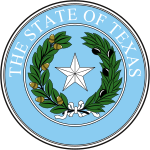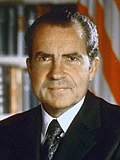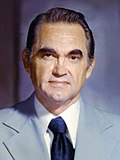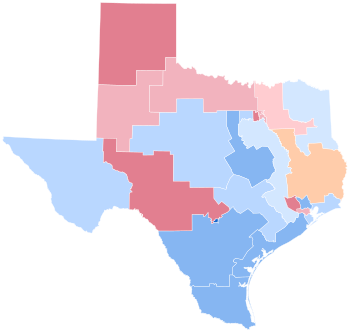| |||||||||||||||||||||||||||||||||
| Turnout | 75.62% (of registered voters) 48.70% (of voting age population)[1] | ||||||||||||||||||||||||||||||||
|---|---|---|---|---|---|---|---|---|---|---|---|---|---|---|---|---|---|---|---|---|---|---|---|---|---|---|---|---|---|---|---|---|---|
| |||||||||||||||||||||||||||||||||
| |||||||||||||||||||||||||||||||||
| |||||||||||||||||||||||||||||||||
| Elections in Texas |
|---|
 |
|
|
The 1968 United States presidential election in Texas was held on November 5, 1968. All 50 states and the District of Columbia, were part of the 1968 United States presidential election. The state chose 25 electors to represent them in the Electoral College, who voted for president and vice president.
The Democratic Party candidate, incumbent Vice President Hubert Humphrey, very narrowly carried Texas with 41.14% of the vote, giving him the state's 25 electoral votes.[2] However, he narrowly lost the general election to Republican candidate, former Vice President Richard Nixon. This was the first occasion when Texas had not backed the winning presidential candidate since voting for John W. Davis in 1924, and the last such occasion until 1992. This is also the most recent presidential election in which Texas would back a losing Democratic candidate, and the penultimate time it voted Democratic.
When Texas "favorite son" Lyndon B. Johnson withdrew from the 1968 election in March, it was generally thought that the Republican Party would have a good chance of winning Texas despite losing by 27 points in 1964 and the presence of former Alabama Governor George Wallace running as a candidate for the American Independent Party, a far-right political party. Wallace was known for his pro-segregationist politics, which would win him five southern states in the general election.[3] However, in Humphrey's favor was the abolition of the poll tax via the Twenty-Fourth Amendment that permitted previously disfranchised Mexican-Americans[3] to register and vote for the first time. The Mexican-American South Texas counties of Duval, Webb and Jim Hogg had been among the four most Democratic in the nation in 1964,[4] and despite polling fewer than eighteen thousand out of a state total exceeding three million votes, those three counties would provide over thirty percent of Humphrey's margin and Duval was again the most Democratic county in the nation.
On September 21, a poll by Joe Belden gave Nixon and Humphrey each thirty percent of the vote and Wallace twenty-five percent.[5] In the period between Belden's poll and the election, Wallace lost considerable support largely to Humphrey, owing chiefly to Democrat Preston Smith's "resolutely law-and-order" campaign for the governorship.[6] This, along with strong loyalty of Texas Democrats much more conservative than the liberal Humphrey,[7] was sufficient to allow the Democrats to carry the state. Exit polls suggest Humphrey gained a third of the non-Hispanic white vote in Texas,[7] vis-à-vis around 25 percent in Virginia and less than 20% in all other southern states.[8]
Wallace, who had been rivaling the two major party nominees in early polls, came in a distant third, with 18.97 percent of the vote, his lowest in any former Confederate state. Wallace did win 21 of Texas' 254 counties, which was enough for him to also carry one congressional district. Wallace's base of support was primarily in rural East Texas, which is more culturally tied to the Deep South than the rest of the state, although he did carry four counties in the West Texas region, with Loving County being the westernmost county in the country to vote for Wallace.
45% of white voters supported Nixon, 34% supported Humphrey, and 22% supported Wallace.[9][10][11]
- ^ Tarrance Jr. 1970, p. 8.
- ^ "1968 Presidential General Election Results – Texas". Retrieved April 24, 2016.
- ^ a b Wainstock, Dennis D.; Election Year 1968: The Turning Point p. 61 ISBN 1936274426
- ^ Dave Leip's U.S. Election Atlas; 1964 Presidential Election Statistics
- ^ ABC News Political Unit; Election Night Fact Book, 1968, p. 149
- ^ Cunningham, Sean P.; American Politics in the Postwar Sunbelt: Conservative Growth in a Battleground Region (Cambridge Essential Histories), p. 140 ISBN 1107024528
- ^ a b Phillips, Kevin P.; The Emerging Republican Majority, p. 281 ISBN 9780691163246
- ^ Phillips; The Emerging Republican Majority, p. 228
- ^ Black & Black 1992, p. 147.
- ^ Black & Black 1992, p. 295.
- ^ Black & Black 1992, p. 335.
Cite error: There are <ref group=lower-alpha> tags or {{efn}} templates on this page, but the references will not show without a {{reflist|group=lower-alpha}} template or {{notelist}} template (see the help page).
© MMXXIII Rich X Search. We shall prevail. All rights reserved. Rich X Search






